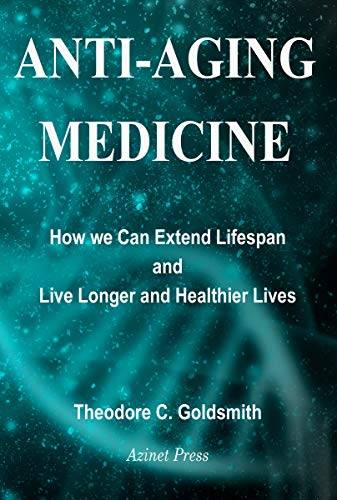

Anti-Aging Medicine: How We Can Extend Lifespan and Live Longer and Healthier Lives
by Theodore C. Goldsmith
Aging is a treatable condition! For more than a century aging and a particular lifespan have been widely thought to be an inescapable and fundamental aspect of human existence. Indeed, Darwin’s evolution theory tells us that the force of evolution is toward defeating aging, leading to the idea that aging is the result of unalterable laws of physics or chemistry. We can find different treatments for different age-related diseases like cancer and heart disease but aging is itself an untreatable fact of life.
Today it is increasingly clear that aging is actually the result of complex biological programs that purposely limit lifespan in humans and most animals because doing so created an evolutionary advantage for populations of wild animals including our prehistoric ancestors. Programmed aging and supporting evolutionary concepts are a logical consequence of relatively recent discoveries in genetics as well as observations regarding the aging and lifespan characteristics of many different organisms. As a consequence, we can increase healthy human lifespan by interfering with the aging program. Interfering with a biological process is a familiar problem in medicine, and research toward developing treatments based on this idea are underway.
Goldsmith describes the 160-year history of still-unresolved scientific arguments over the evolutionary nature of aging, the increasing empirical evidence of aging programs, and the exciting prospects for lifespan extension and healthy living. More practically, the book describes:
Contents
1. Introduction
2. Nature of Aging and Lifespan
3. Evolution Theory and Aging
4. Evidence Supporting Programmed Aging
5. U.S. Health System Summary
6. Exercise and Activity - Effects on Aging
7. Non-Science Factors Favor Non-Programmed Aging
8. Programmed vs Non-Programmed Aging – Current Status
9. Anti-Aging Research
10. Anti-Aging Medicine
11. Conclusion
12. Free Resources and Further Reading
13. Appendix
14. Glossary
15. References
Today it is increasingly clear that aging is actually the result of complex biological programs that purposely limit lifespan in humans and most animals because doing so created an evolutionary advantage for populations of wild animals including our prehistoric ancestors. Programmed aging and supporting evolutionary concepts are a logical consequence of relatively recent discoveries in genetics as well as observations regarding the aging and lifespan characteristics of many different organisms. As a consequence, we can increase healthy human lifespan by interfering with the aging program. Interfering with a biological process is a familiar problem in medicine, and research toward developing treatments based on this idea are underway.
Goldsmith describes the 160-year history of still-unresolved scientific arguments over the evolutionary nature of aging, the increasing empirical evidence of aging programs, and the exciting prospects for lifespan extension and healthy living. More practically, the book describes:
- Key observations about the nature of aging.
- Orally administered substances known to increase longevity in mice.
- Why exercise increases longevity.
- Anti-aging medicine issues with existing health care systems.
- Social, educational, ethical, and economic issues with extending lifespan.
- How lifespan extension concepts add to our ability to devise treatments for age-related diseases.
Contents
1. Introduction
2. Nature of Aging and Lifespan
3. Evolution Theory and Aging
4. Evidence Supporting Programmed Aging
5. U.S. Health System Summary
6. Exercise and Activity - Effects on Aging
7. Non-Science Factors Favor Non-Programmed Aging
8. Programmed vs Non-Programmed Aging – Current Status
9. Anti-Aging Research
10. Anti-Aging Medicine
11. Conclusion
12. Free Resources and Further Reading
13. Appendix
14. Glossary
15. References

